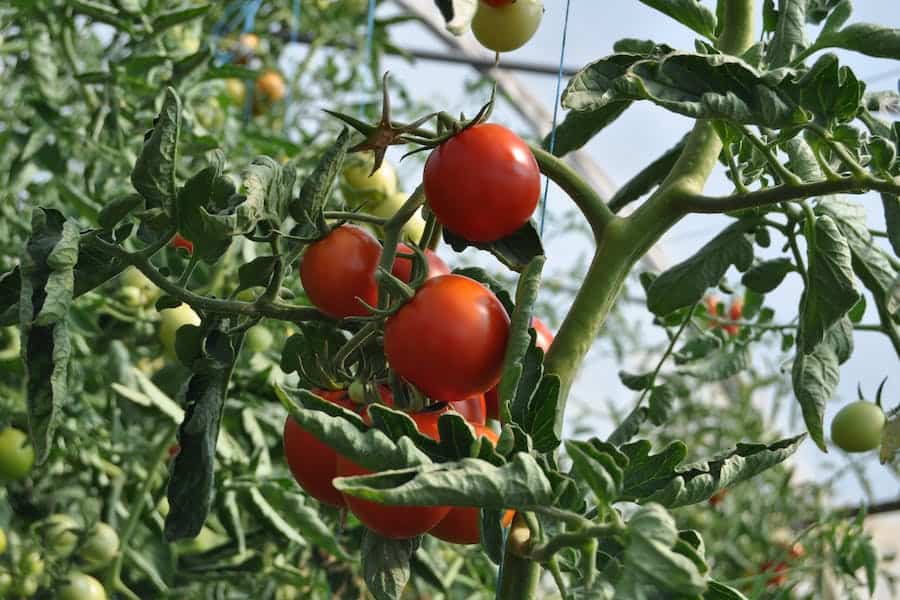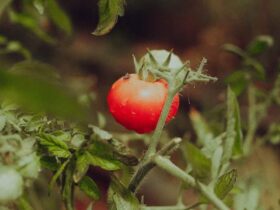A vibrant green sea of thriving tomato plants laden with juicy, sun-kissed fruits is a vision cherished by every gardener. It whispers the untold promise of delightful salads, rich sauces, and flavorsome sun-dried treats, encapsulating the very essence of summer in every bite. But behind this idyllic image lies a journey steeped in dedicated care, beginning from the very first moment a seed bursts into life beneath the soil. It’s an adventurous odyssey that traverses through various stages, from the tender, fragile days of a sprouting seed to the robust vitality of a fruit-bearing plant. An essential companion on this journey is nutrition, meticulously provided through timely and adequate fertilization. Understanding when to introduce tomato seedlings to their first taste of fertilizer becomes a pivotal chapter in this gardening story, ensuring the sustenance and strength they require to eventually transform into a bountiful harvest. Guiding these fledgling plants through their early days by arming them with the nutritional armor they need to fend off challenges and grow unabated lays the foundation for a healthy and prosperous tomato crop. Journey with us as we delve into the nuanced world of fertilizing tomato seedlings, exploring the whens and hows of nourishing these future crimson jewels, and unlocking the secrets to a flourishing tomato garden.
When To Fertilize Tomato Seedlings?
Fertilizing tomato seedlings is crucial for healthy development, and it typically begins when they develop their first true leaves, which is generally 2-3 weeks after germination. At this stage, using a balanced, water-soluble fertilizer diluted to half the recommended strength provides gentle and adequate nourishment. Subsequently, fertilize every 2-3 weeks while the plants are in their rapid growth phase. Ensure you follow specific fertilizer guidelines and consider the nutrient content of your soil to avoid over or under-fertilization, ensuring a hearty and abundant tomato harvest.
Appropriate Timing For Fertilizing Tomato Seedlings
Navigating through the initial phases of tomato plant growth requires understanding the critical moments that mandate nutritional intervention through fertilization. To catapult your seedlings towards a future of lush, fruitful maturity, let’s explore the chronological touchpoints for fertilization in a stepwise manner.
- Post-Germination Nourishment: Upon germination, tomato seeds unfurl their cotyledons – the initial seed leaves. The subsequent appearance of true leaves, generally 2-3 weeks post-germination, signals the apt time for introducing a half-strength, balanced fertilizer. This early phase nutrition facilitates robust root development and establishes a formidable foundation for future growth.
- Transition To Vegetative Growth: When seedlings attain a height of 3-4 inches, with several sets of true leaves, they transition into a rapid vegetative growth phase. During this period, augmenting nutrition via a high-nitrogen fertilizer every 2-3 weeks can invigorate the foliage development, ensuring that the plants are stocky and robust rather than tall and leggy.
- Preparing For Flowering: As your plants are near the flowering stage, a slight shift in nutrient emphasis is paramount. Switching to a fertilizer higher in phosphorous about two weeks before the first flowers appear pre-conditions the plant for robust flowering and eventual fruit development, setting the stage for a bountiful harvest.
- Supporting Fruit Set And Development: Upon the emergence of flowers and subsequent fruit sets, a consistent fertilization regimen fortified with higher potassium and phosphorous will bolster fruit development. Implementing a consistent fertilizing schedule, spaced at 3-4 week intervals, will ensure sustained nourishment throughout the crucial fruit-bearing phase.
- Tapering Off As Harvest Nears: As fruits ripen and approach harvest, gradually tapering off fertilization will assist the plant in channeling energy toward fruit maturation rather than vegetative growth. This strategic reduction will optimize the quality and flavor of the tomatoes.
Methods Of Fertilizing Tomato Seedlings
Embarking on a journey of nurturing tomato seedlings to fruition, understanding diverse fertilization methods can indeed shape the trajectory towards a flourishing harvest. Fertilization isn’t merely about what nutrients to provide but encompasses how we introduce these vital elements into the life of a burgeoning plant. The methodology employed in fertilization must be congruent with the developmental phase, nutritional requirements, and environmental conditions experienced by the tomato seedlings. So, let’s explore distinct approaches in fertilization to discern the optimal pathway for nourishing your budding tomatoes.
Soil Application: Direct Incorporation
The roots are a plant’s primary channel for nutrient uptake, making soil applications of fertilizer a widely adopted method. Direct incorporation involves uniformly mixing fertilizer into the soil, ensuring nutrients permeate the root zone. Particularly for seedlings, a gentle hand is needed. Ensuring fertilizers are adequately diluted and thoroughly mixed into the soil mitigates the risk of root burn while establishing a nutrient-rich environment for emerging roots.
Soil Application: Top-Dressing
Top-dressing entails sprinkling fertilizer on the soil surface, where it gradually percolates downward with subsequent watering. This method allows for a steady, slow release of nutrients, which is particularly beneficial during the vegetative and fruiting stages, ensuring sustained nutritional availability. However, care must be taken to prevent direct contact between the fertilizer and the seedlings to avoid potential damage.
Foliar Application:
Foliar feeding involves applying liquid fertilizer directly to the leaves, offering an expedited nutrient uptake pathway. Especially when seedlings exhibit signs of nutrient deficiency, a swift foliar application can render immediate remediation. It’s vital to employ a well-diluted solution and to apply it during cooler parts of the day, such as early morning or late afternoon, to circumvent potential leaf burn and ensure optimal absorption.
Root Drench Method:
Root drenching involves saturating the soil around the roots with a liquid fertilizer solution, providing nutrients directly where the plant needs them most. This method can be especially useful during transplant shock or periods of stress, delivering immediate nourishment to the roots and bolstering recovery and continued growth. It’s imperative that the solution is adequately diluted to prevent root burn and to ensure a gentle, supportive nutritional boost.
Slow-Release Fertilizers:
Slow-release fertilizers, often available in granular form, gradually dispense nutrients into the soil over extended periods. These can be judiciously incorporated into the soil during planting, offering a continual nutrient supply that supports sustained growth without the need for frequent fertilizer applications. This method reduces labor and mitigates nutrient loss through leaching, offering an efficient, low-maintenance fertilization strategy.
Organic Fertilization:
Organic fertilization, deploying materials like compost, worm castings, or fish emulsion, offers a holistic, environmentally friendly approach to nourishment. These methods not only supply vital nutrients but also enhance soil structure, microbiology, and long-term fertility. Implementing organic fertilizers demands an understanding of the nutrient composition and release rates of these materials to align them appropriately with the nutritional requirements of the developmental stage.
Automated Fertilization Systems:
For those navigating the demands of large-scale tomato cultivation, automated fertilization systems, integrated with irrigation (fertigation), offer precise, labor-efficient nutrient management solutions. These systems enable meticulous control over nutrient ratios and concentrations, ensuring optimal nutrient availability throughout each developmental stage.
Common Mistakes In Fertilizing Tomato Seedlings
Embarking on the journey of nurturing tomato seedlings to fruition requires both care and knowledge. Fertilization, while integral to healthy plant development, can be a delicate task where errors may inadvertently happen. Recognizing and understanding the common mistakes in fertilizing tomato seedlings could spell the difference between a bounteous harvest and unfulfilled potential.
- Over-Fertilization: One of the most frequent missteps in nurturing tomato seedlings is over-fertilization. An excess of nutrients, particularly nitrogen, can lead to lush, rapid vegetative growth at the expense of fruit formation, often resulting in diminished yields and potentially even damaging the delicate seedlings. Plants overwhelmed with nitrogen tend to prioritize leaf and stem development, significantly delaying or minimizing fruit production. Additionally, overly concentrated fertilizers can burn delicate roots, thereby hindering nutrient uptake and stunting growth.
- Neglecting Soil Tests: Another common error is neglecting the invaluable insight provided by soil tests. A comprehensive soil test lays bare the existing nutrient levels, pH, and composition of the soil, guiding tailored fertilization that precisely complements existing conditions. Fertilizing without understanding the soil’s inherent characteristics can result in inappropriate nutrient applications, either depriving the plant of essential elements or inundating it with excesses.
- Incorrect Fertilizer Composition: Choosing an incorrect fertilizer composition is yet another pitfall. As tomatoes progress through various developmental stages, their nutrient requirements evolve. Utilizing a fertilizer with an inappropriate nutrient ratio can misalign with the plant’s current needs. For instance, excessive nitrogen during the flowering and fruiting stages can suppress these very processes, while inadequate phosphorous might impede robust root development.
- Inconsistent Fertilization Schedule: Inconsistency in the fertilization schedule often impedes the optimal growth and development of tomato plants. Timely, routine applications, harmonized with the plant’s developmental phases, ensure consistent nutrient availability, supporting uninterrupted growth and development. Erratic or sporadic applications can subject plants to nutritional stress, impeding their progress and potentially affecting yield quality and quantity.
- Overlooking Micronutrients: A frequent oversight involves focusing solely on the macronutrients nitrogen, phosphorous, and potassium – while neglecting essential micronutrients like calcium, magnesium, and sulfur. Micronutrient deficiencies can manifest in various adverse ways, such as blossom end rot (commonly associated with calcium deficiency) or leaf chlorosis (often linked to magnesium deficiency). Ensuring a comprehensive nutrient supply, which addresses both macro and micronutrient needs, is pivotal in nurturing robust, productive tomato plants.
Wrapping Up
In the mesmerizing journey from a dormant seed to a fruitful tomato plant, the act of fertilizing isn’t merely a chore; it’s an intricate dance meticulously timed to align with the rhythm of the seedling’s growth and developmental cues. Deciphering “when” to fertilize tomato seedlings entails immersing oneself into a realm where understanding the subtle yet profound phases of their life cycle becomes paramount. From the emergence of the first true leaves, signaling the readiness for initial nutrient intake, to the nuanced shifts in nutritional demands as they evolve through vegetative growth and into fruitful maturity, each stage delineates a specific narrative in nutrient requirements. The act of fertilizing, thus, transforms into a supportive dialogue between the cultivator and the seedling, ensuring that the nutritional crescendo harmonizes perfectly with each developmental milestone.
FAQ’s
Can You Use 20-20-20 Fertilizer On Tomato Plants?
Yes, you can use a 20-20-20 fertilizer on tomato plants, especially in their initial growing stages. This balanced fertilizer provides equal parts Nitrogen, Phosphorus, and Potassium, essential for promoting healthy foliage growth (N), root development (P), and fruit production (K). However, as the plants mature and enter the flowering and fruiting stages, they typically benefit more from a fertilizer with a higher Phosphorus content to promote flower production and fruit set. Always follow the product guidelines to prevent over-fertilization.
Can You Overwater Tomato Seedlings?
Absolutely, tomato seedlings can indeed be overwatered. While they require consistently moist soil, excessive water can lead to a host of problems, including root rot and a condition known as “damping off,” which is a fungal disease that can be fatal to young seedlings. Signs of overwatering include yellowing leaves and a wilting appearance, even with wet soil. Employ a well-draining soil medium and containers with adequate drainage holes to mitigate overwatering risks. Ensure to keep the soil consistently moist, not soggy, to support healthy growth.
Can You Over-Fertilize Tomato Seedlings?
Yes, over-fertilization of tomato seedlings is a common mistake that can lead to detrimental outcomes. Excessive fertilizer, particularly nitrogen-rich formulas, can promote lush, rapid foliage growth at the expense of fruit development. Moreover, too much fertilizer can cause salt accumulation in the soil, leading to “fertilizer burn,” visible as brown, scorched-looking leaf edges and stunted growth. It’s crucial to adhere to recommended fertilizer application rates and schedules, ensuring that the nutritional needs of the tomato seedlings are met without overwhelming them with an excess of nutrients.




















Leave a Reply